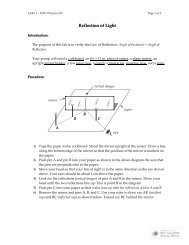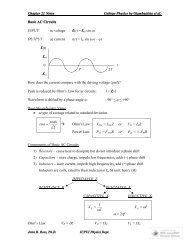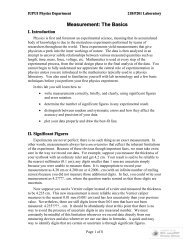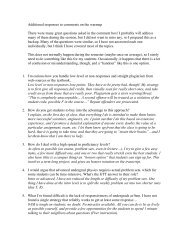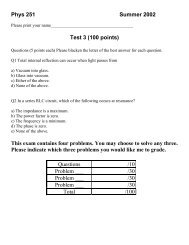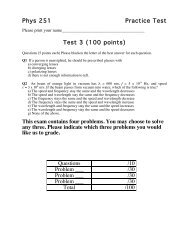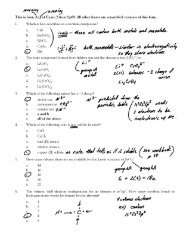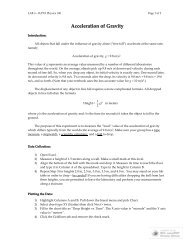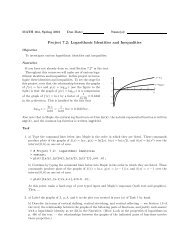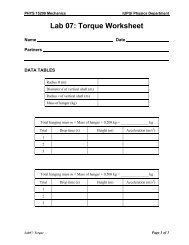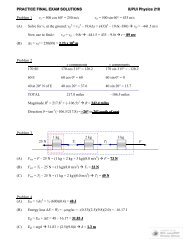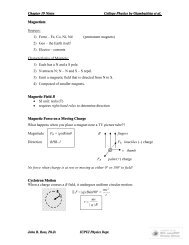Ross (jr6585) â Hw14 â Ross â (89251) 1 This print ... - WebPhysics
Ross (jr6585) â Hw14 â Ross â (89251) 1 This print ... - WebPhysics
Ross (jr6585) â Hw14 â Ross â (89251) 1 This print ... - WebPhysics
Create successful ePaper yourself
Turn your PDF publications into a flip-book with our unique Google optimized e-Paper software.
<strong>This</strong> <strong>print</strong>-out should have 8 questions.<br />
Multiple-choice questions may continue on<br />
the next column or page – find all choices<br />
before answering.<br />
001 (part 1 of 4) 10.0 points<br />
The figure below shows a straight cylindrical<br />
coaxial cable of radii a, b, and c in which<br />
equal, uniformly distributed, but antiparallel<br />
currents i exist in the two conductors.<br />
a<br />
i out ⊙<br />
b<br />
c<br />
i in ⊗<br />
O<br />
F<br />
E<br />
D<br />
C<br />
<strong>Ross</strong> (<strong>jr6585</strong>) – <strong>Hw14</strong> – <strong>Ross</strong> – (<strong>89251</strong>) 1<br />
r 1<br />
r 2<br />
r 3<br />
r 4<br />
Which expression gives the magnitude of<br />
the magnetic field in the region r 1 < c (at F)?<br />
1. B(r 1 ) = µ 0 i (r 2 1 − b2 )<br />
2 π r 1 (a 2 − b 2 )<br />
2. B(r 1 ) = µ 0 i r 1<br />
2 π c 2<br />
3. B(r 1 ) = µ 0 i (a 2 + r 2 1 − 2 b2 )<br />
2 π r 1 (a 2 − b 2 )<br />
4. B(r 1 ) = µ 0 i r 1<br />
2 π b 2<br />
5. B(r 1 ) = 0<br />
6. B(r 1 ) = µ 0 i<br />
π r 1<br />
7. B(r 1 ) = µ 0 i (a 2 − r 2 1 )<br />
2 π r 1 (a 2 − b 2 )<br />
8. B(r 1 ) = µ 0 i r 1<br />
2 π a 2<br />
9. B(r 1 ) = µ 0 i (a 2 − b 2 )<br />
2 π r 1 (r 2 1 − b2 )<br />
10. B(r 1 ) = µ 0 i<br />
2 π r 1<br />
002 (part 2 of 4) 10.0 points<br />
Which expression gives the magnitude of the<br />
magnetic field in the region c < r 2 < b (at<br />
E)?<br />
1. B(r 2 ) = µ 0 i<br />
2 π r 2<br />
2. B(r 2 ) = µ 0 i (r 2 2 − b2 )<br />
2 π r 2 (a 2 − b 2 )<br />
3. B(r 2 ) = µ 0 i r 2<br />
2 π a 2<br />
4. B(r 2 ) = µ 0 i (a 2 − b 2 )<br />
2 π r 2 (r 2 2 − b2 )<br />
5. B(r 2 ) = µ 0 i r 2<br />
2 π b 2<br />
6. B(r 2 ) = 0<br />
7. B(r 2 ) = µ 0 i r 2<br />
2 π c 2<br />
8. B(r 2 ) = µ 0 i (a 2 − r 2 2 )<br />
2 π r 2 (a 2 − b 2 )<br />
9. B(r 2 ) = µ 0 i<br />
π r 2<br />
10. B(r 2 ) = µ 0 i (a 2 + r 2 2 − 2 b2 )<br />
2 π r 2 (a 2 − b 2 )<br />
003 (part 3 of 4) 10.0 points<br />
Which expression gives the magnitude of the<br />
magnetic field in the region b < r 3 < a (at<br />
D)?<br />
1. B(r 3 ) = µ 0 i r 3<br />
2 π a 2<br />
2. B(r 3 ) = µ 0 i r 3<br />
2 π c 2<br />
3. B(r 3 ) = µ 0 i (a 2 − r 2 3 )<br />
2 π r 3 (a 2 − b 2 )<br />
4. B(r 3 ) = µ 0 i (a 2 + r 2 3 − 2 b2 )<br />
2 π r 3 (a 2 − b 2 )<br />
5. B(r 3 ) = µ 0 i<br />
2 π r 3<br />
6. B(r 3 ) = µ 0 i r 3<br />
2 π b 2
7. B(r 3 ) = µ 0 i<br />
π r 3<br />
8. B(r 3 ) = 0<br />
9. B(r 3 ) = µ 0 i (r 2 3 − b2 )<br />
2 π r 3 (a 2 − b 2 )<br />
10. B(r 3 ) = µ 0 i (a 2 − b 2 )<br />
2 π r 3 (r 2 3 − b2 )<br />
004 (part 4 of 4) 10.0 points<br />
Which expression gives the magnitude of the<br />
magnetic field in the region r 4 > a (at C)?<br />
<strong>Ross</strong> (<strong>jr6585</strong>) – <strong>Hw14</strong> – <strong>Ross</strong> – (<strong>89251</strong>) 2<br />
z<br />
y<br />
Find the magnitude of each current. Answer<br />
in units of A.<br />
a<br />
θ<br />
x<br />
1. B(r 4 ) = 0<br />
2. B(r 4 ) = µ 0 i<br />
π r 4<br />
3. B(r 4 ) = µ 0 i (a 2 − r4 2)<br />
2 π r 4 (a 2 − b 2 )<br />
4. B(r 4 ) = µ 0 i (a 2 − b 2 )<br />
2 , π r 4 (r4 2 − b2 )<br />
5. B(r 4 ) = µ 0 i (a 2 + r4 2 − 2 b2 )<br />
2 π r 4 (a 2 − b 2 )<br />
6. B(r 4 ) = µ 0 i<br />
2 π r 4<br />
7. B(r 4 ) = µ 0 i r 4<br />
2 π c 2<br />
8. B(r 4 ) = µ 0 i r 4<br />
2 π a 2<br />
9. B(r 4 ) = µ 0 i (r 2 4 − b2 )<br />
2 π r 4 (a 2 − b 2 )<br />
10. B(r 4 ) = µ 0 i r 4<br />
2 π b 2<br />
005 10.0 points<br />
Two long, parallel wires, each having a mass<br />
per unit length of 46.2 g/m, are supported in a<br />
horizontal plane by strings 3.21 cm long, as in<br />
the figure. Each wire carries the same current<br />
I, causing the wires to repel each other so<br />
that the angle between the supporting strings<br />
is 22.53 ◦ .<br />
The acceleration due to gravity is 9.8 m/s 2<br />
and the permeability of free space is 1.25664×<br />
10 −6 T · m/A.<br />
006 10.0 points<br />
A long cylindrical shell has a uniform current<br />
density. The total current flowing through<br />
the shell is 16 mA.<br />
The permeability of free space is<br />
1.25664 × 10 −6 T · m/A.<br />
6 cm<br />
3 cm<br />
The current<br />
is 16 mA .<br />
14 km<br />
•<br />
Find the magnitude of the magnetic field at<br />
a point r 1 = 4.4 cm from the cylindrical axis.<br />
Answer in units of nT.<br />
007 10.0 points<br />
A conductor consists of an infinite number<br />
of adjacent wires, each infinitely long and<br />
carrying a current I (whose direction is out-ofthe-page),<br />
thus forming a conducting plane.<br />
A<br />
C<br />
If there are n wires per unit length, what is
<strong>Ross</strong> (<strong>jr6585</strong>) – <strong>Hw14</strong> – <strong>Ross</strong> – (<strong>89251</strong>) 3<br />
the magnitude of ⃗ B?<br />
1. B = µ 0 I<br />
2. B = 2 µ 0 n I<br />
3. B = µ 0 n I<br />
4. B = µ 0 I<br />
2<br />
5. B = 4 µ 0 I<br />
6. B = 4 µ 0 n I<br />
7. B = µ 0 n I<br />
4<br />
8. B = µ 0 I<br />
4<br />
9. B = 2 µ 0 I<br />
10. B = µ 0 n I<br />
2<br />
008 10.0 points<br />
What current is required in the windings of a<br />
long solenoid that has 1245 turns uniformly<br />
distributed over a length of 0.388 m in order<br />
to produce inside the solenoid a magnetic field<br />
of magnitude 9.52×10 −5 T? The permeablity<br />
of free space is 1.25664×10 −6 T m/A. Answer<br />
in units of mA.



